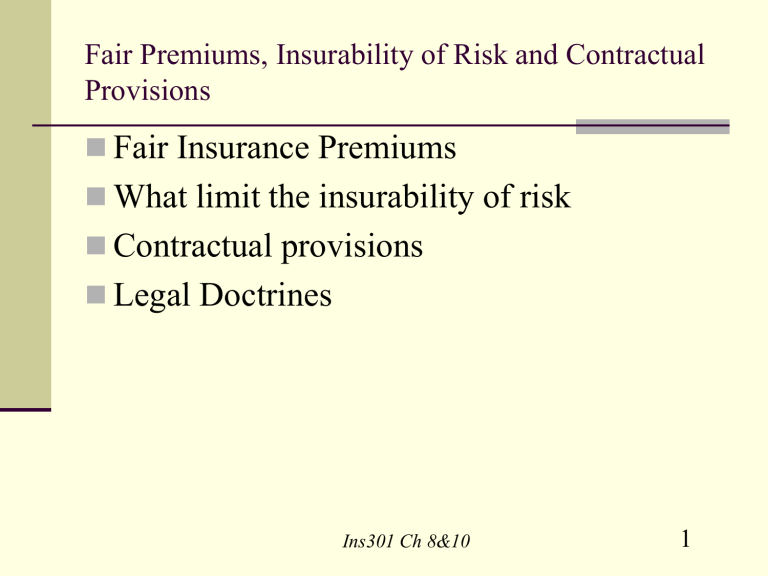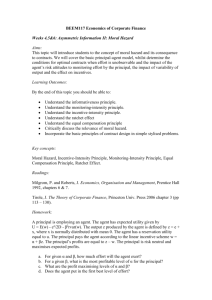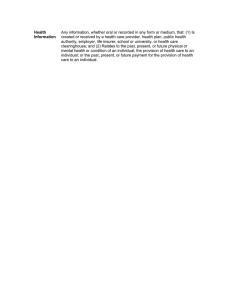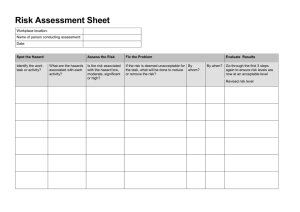
Fair Premiums, Insurability of Risk and Contractual Provisions Fair Insurance Premiums What limit the insurability of risk Contractual provisions Legal Doctrines Ins301 Ch 8&10 1 Insurance Costs and Fair Premiums Fair premium The premium level that is just sufficient to fund the insurer’s expected costs and provide insurance company owners with a fair return on their investment. It includes Expected claim costs Investment income Administrative costs Fair profit loading Ins301 Ch 8&10 2 Claim tail and present value The lag between the time that coverage is sold and claims are paid is known as the claim tail. It affects expected losses Ins301 Ch 8&10 3 Example Suppose a liability claim longs for 3 years. In the first year, the loss amount on average is $700. In the second year, the loss amount is $200. the loss amount is $100 in the third year. Interest rate is 5%. What is the expected loss? Ins301 Ch 8&10 4 Premium loadings Two Bicycles one worth $200 and the other worth $6000. Assume that the probability of each bike being stolen is 0.05. Assume that the fixed costs of paying employees to market, underwrite, and process an application for bike insurance are $100 and that capital costs are 0. ignoring investment income, what are the fair premiums for both? Ins301 Ch 8&10 5 Moral Hazard If you purchase a full-coverage theft insurance, will you still take precautions to reduce the likelihood of theft? Ins301 Ch 8&10 6 Conditions for Moral Hazard Two conditions cause moral hazard Expected losses depend on insured’s behavior Effect of behavior on expected losses is costly to observe and measure Example: Claim costs increase with driving speed Costly for insurers to monitor driving speed Ins301 Ch 8&10 7 Adverse Selection If insurer is unable to distinguish between the two types of consumers with different risk level and thus change them the same premium, what will happen? Ins301 Ch 8&10 8 Factors Limiting the Insurability of Risk Ins301 Ch 8&10 9 Deductibles Example: policy with a $500 deductible then policyholder pays first $500 of losses Types of deductibles per occurrence aggregate Ins301 Ch 8&10 10 Deductibles and Claim Processing Costs Deductibles reduce cost of processing small claims Example: Fixed claim processing cost of $200 Loss = $2000 100 0 with probability 0.01 with probability 0.10 with probability 0.89 Expected claim cost w/o a deductible = ______ Expected claim cost w a $100 deductible = ______ Marginal cost of insuring the $100 loss equals _______ Ins301 Ch 8&10 11 Deductibles, Moral Hazard, and Adverse Selection Deductibles reduce moral hazard why? Deductibles might be used to reduce adverse selection. How? Ins301 Ch 8&10 12 Coinsurance With coinsurance, insured pays a proportion (the coinsurance rate) of any loss Example: Insured pays 20% of all medical costs Reason for coinsurance provisions Insureds demand less than full insurance when the policy has a loading Reduce moral hazard Ins301 Ch 8&10 13 Policy Limits A policy limit is the maximum amount that the insurer will pay Liability insurance always has a policy limit Property insurance often has a policy limit Ins301 Ch 8&10 14 Purpose of Policy Limits Reduce classification costs when consumers have information that is costly for insurers to obtain Example: Homeowners’ policy might limit coverage for jewelry losses to $2,500 Those with more expensive jewelry buy special coverage Insurer does not have to investigate the value of each policyholder’s jewelry Ins301 Ch 8&10 15 Pro Rata and Excess Coverage Clauses Issue: How is coverage divided when multiple policies apply to the same loss Pro rata clause: divide in proportion to amount of coverage Excess clause: one policy pays losses in excess of the other policy’s limit Why have these clauses? prevent coverage in excess of loss, which would cause moral hazard Ins301 Ch 8&10 16 Exclusions Policies exclude coverage for some types of losses Why? reduce administrative costs reduce capital costs reduce moral hazard reduce adverse selection Ins301 Ch 8&10 17 Indemnity versus Valued Contracts Indemnity contract - insurer pays based on the amount of loss that occurred Example: auto physical damage Valued contract - insurer pays a pre-determined amount Example: life insurance Ins301 Ch 8&10 18 Indemnity versus Valued Contracts Type of contract is largely explained by The costs of assessing value: when the amount of loss can be assessed at low cost following the loss, more likely to have indemnity contracts Moral hazard: when moral hazard is less likely to be a problem, fixing the insurance payment before a loss can avoid costly haggling following a loss (e.g., life insurance) Ins301 Ch 8&10 19 Insurance-to-Value in Property Insurance Also called coinsurance Specifies the percentage of the property’s value that must be insured to receive full reimbursement in the event of a loss Typical coinsurance percentage is 80% Ins301 Ch 8&10 20 Legal Doctrines Indemnity principle: an insurance policy cannot pay more than the financial loss suffered. Insurable interest: if you want to get paid from insurance company, you got to have interest. Example, A and B are not related, A buys a life insurance and set B as the beneficiary Subrogation: after a party receives claim payment from an insurer, it has to transfer the right to seek additional compensation to the insurer Ins301 Ch 8&10 21 Legal Doctrines Utmost good faith Misrepresentation (page 195) Concealment (196) Contract of adhesion Favors insureds, if disagreement Doctrine of reasonable expectation Policies would be interpreted based on the expectation of a person who is trained in the law. Ins301 Ch 8&10 22



